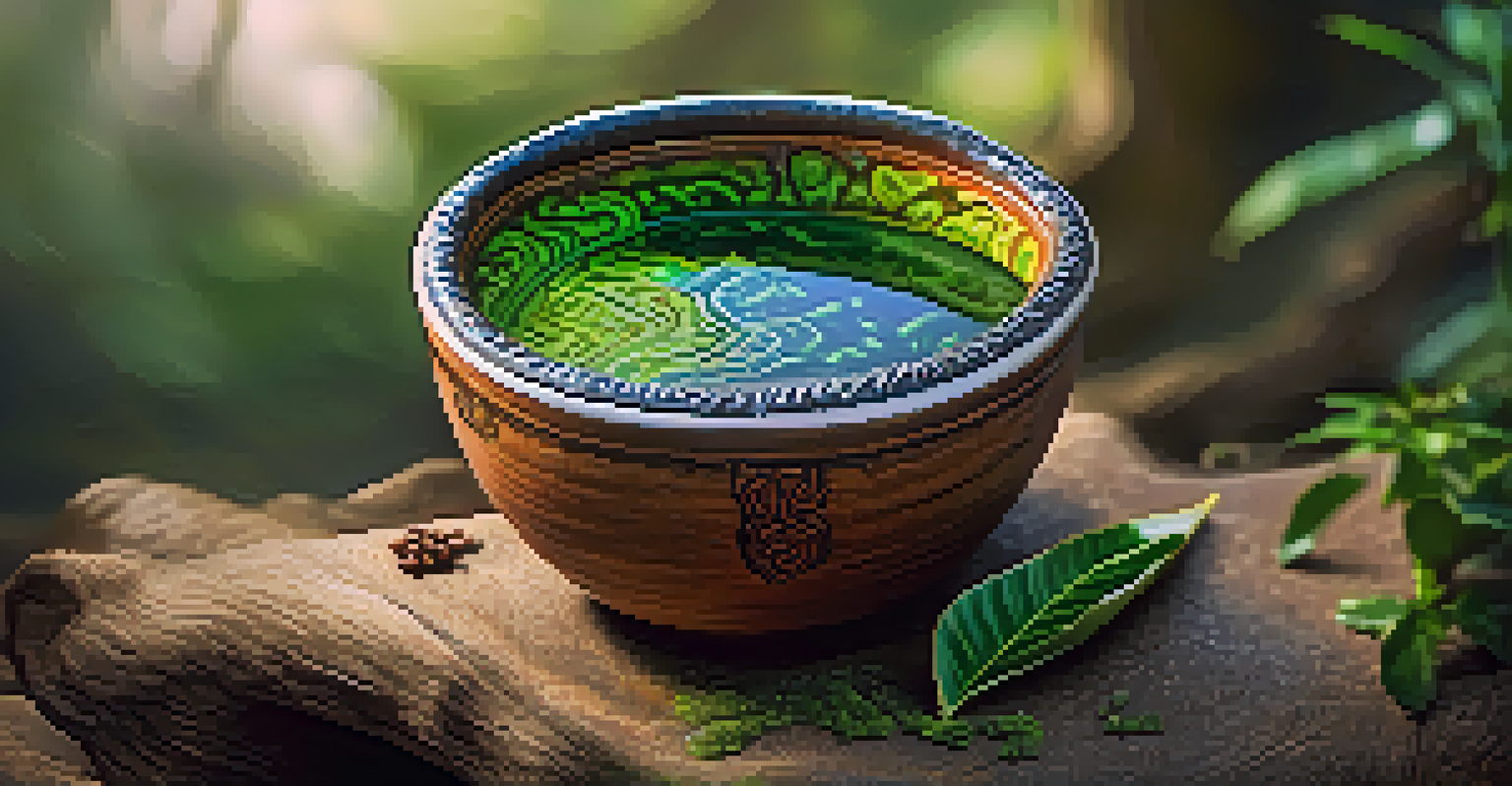Cultural Context vs. Scientific Evidence: Ayahuasca Debate

Understanding Ayahuasca: A Cultural Perspective
Ayahuasca, a traditional brew from the Amazon rainforest, is steeped in cultural significance. Indigenous tribes have used it for centuries in spiritual ceremonies, believing it offers profound insights and healing. This rich cultural context shapes how Ayahuasca is perceived and utilized within these communities, often as a sacred tool for connection with the divine.
The experience of Ayahuasca is about more than just the brew; it’s about the journey, the setting, and the community that supports it.
For many practitioners, the experience is not just about the substance but the entire ritual surrounding it. The setting, the guidance of a shaman, and the communal aspect all contribute to the perceived benefits. This highlights the importance of understanding the cultural framework when discussing Ayahuasca’s effects, as it cannot be separated from its traditional roots.
However, as the West becomes more interested in Ayahuasca, it raises questions about cultural appropriation and the commodification of these sacred practices. It’s essential to respect and honor the traditions while exploring the potential benefits of Ayahuasca in a broader context.
Scientific Evidence: What Do the Studies Show?
In recent years, scientific research on Ayahuasca has gained traction, with studies exploring its psychological and physiological effects. Some research suggests that compounds in Ayahuasca, particularly DMT and harmine, may have therapeutic properties, potentially aiding in the treatment of depression and PTSD. These findings have sparked interest in using Ayahuasca in clinical settings.

However, the scientific community remains divided on the extent of these benefits. Critics argue that many studies lack rigorous methodology and large sample sizes, raising questions about the validity of the claims. This calls for more comprehensive research to establish a clearer understanding of how Ayahuasca interacts with the human body and mind.
Cultural Roots of Ayahuasca Use
Ayahuasca serves as a sacred tool for indigenous tribes, emphasizing its significance in spiritual ceremonies and community healing.
Moreover, the challenge lies in the fact that scientific study often strips away the cultural context, focusing solely on the biochemical aspects. This can lead to a reductionist view that overlooks the holistic experience that practitioners describe, making it vital to bridge the gap between these two perspectives.
The Intersection of Culture and Science
The debate surrounding Ayahuasca highlights a fascinating intersection between culture and science. On one hand, you have the rich, immersive experiences of indigenous communities, and on the other, the clinical, evidence-based approach of scientific inquiry. Finding common ground between these two realms can lead to a more holistic understanding of Ayahuasca’s potential.
Understanding Ayahuasca requires an appreciation of both its cultural roots and its potential therapeutic benefits.
For instance, incorporating cultural practices into scientific studies could enrich our understanding of the effects of Ayahuasca. Researchers might consider how the ceremonial context influences outcomes, potentially leading to more effective therapeutic protocols. This collaboration could pave the way for respectful and informed use of Ayahuasca in various settings.
Ultimately, acknowledging both cultural and scientific perspectives can create a more nuanced narrative around Ayahuasca. It encourages a dialogue that respects indigenous knowledge while also pursuing scientific validation, fostering a deeper understanding of this complex brew.
Cultural Significance: Healing Beyond the Brew
For many indigenous populations, Ayahuasca is more than just a psychoactive substance; it represents a holistic approach to healing that encompasses mind, body, and spirit. The ceremonies often involve songs, chants, and community support, creating an environment conducive to personal transformation. This rich tapestry of practices underscores the importance of community and tradition in the healing process.
In contrast, the Western approach may lean towards isolating the chemical properties of Ayahuasca, focusing primarily on its active ingredients. This raises concerns that the deeper, more meaningful aspects of the experience could be overlooked. Healing, in indigenous contexts, is often relational and communal, rather than purely individualistic.
Scientific Research on Ayahuasca
While studies indicate potential therapeutic benefits of Ayahuasca, the scientific community calls for more rigorous research to validate these claims.
By recognizing the broader cultural significance of Ayahuasca, we can appreciate its role in promoting well-being beyond mere pharmacological effects. This understanding invites a more respectful approach to its use, allowing for a more comprehensive exploration of its potential benefits.
Risks and Ethical Considerations
As interest in Ayahuasca grows, so do concerns regarding its safety and the ethical implications of its use. Some individuals may experience challenging psychological effects during ceremonies, such as anxiety or emotional distress. Without proper guidance and support, these experiences could be overwhelming, highlighting the need for qualified facilitators who respect traditional practices.
Moreover, the increasing commercialization of Ayahuasca retreats raises ethical questions about who benefits from these practices. Are indigenous communities adequately compensated for their knowledge and traditions? It’s crucial to consider the implications of turning a sacred ritual into a commodity, which can exploit the very cultures that have preserved these practices for generations.
Addressing these risks and ethical considerations is essential for fostering a respectful and safe environment for those seeking Ayahuasca experiences. Open conversations about these topics can help bridge the gap between curiosity and cultural respect, ensuring that the use of Ayahuasca honors its origins.
Personal Experiences: Voices from the Community
Personal narratives from those who have participated in Ayahuasca ceremonies provide valuable insights into the debate. Many participants describe transformative experiences that challenge their perceptions of reality and self. These stories often highlight the deep emotional and spiritual connections fostered during the ceremonies, emphasizing the subjective nature of the Ayahuasca experience.
However, not all experiences are positive, and some individuals report adverse reactions. These testimonials underscore the variability of individual responses to Ayahuasca, raising important questions about preparation and integration following the experience. It’s crucial for individuals to approach these ceremonies with awareness and intention, understanding that each journey is unique.
Navigating Ethical Considerations
The growing commercialization of Ayahuasca raises ethical concerns about cultural appropriation and the need for proper guidance in ceremonies.
Sharing personal stories enriches the dialogue around Ayahuasca, offering a more nuanced perspective that complements scientific research and cultural context. By listening to these voices, we can better appreciate the complexities and potential of Ayahuasca in the modern world.
Towards a Balanced Understanding of Ayahuasca
As we navigate the complex landscape of the Ayahuasca debate, it becomes clear that a balanced understanding is essential. Embracing the cultural significance while acknowledging scientific inquiry allows for a more comprehensive view of this powerful brew. It encourages us to appreciate both the subjective experiences of individuals and the objective data provided by research.
This balanced approach can lead to more informed discussions about the use of Ayahuasca in therapeutic settings. It opens the door for collaborative efforts between scientists, indigenous practitioners, and participants to create safe and respectful environments for exploration. Such collaboration could ultimately enhance our understanding of Ayahuasca’s potential benefits and risks.

In conclusion, as we continue to explore the intersection of cultural context and scientific evidence, we must remain open to learning from both realms. Only through this integrative approach can we truly honor the complexities of Ayahuasca and its place in both traditional and contemporary contexts.